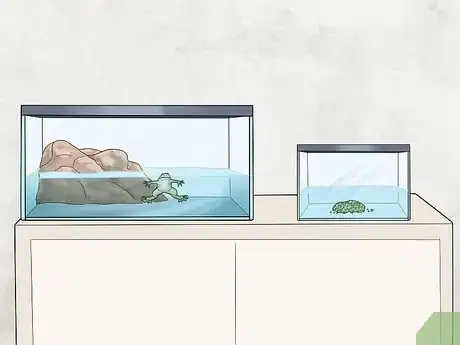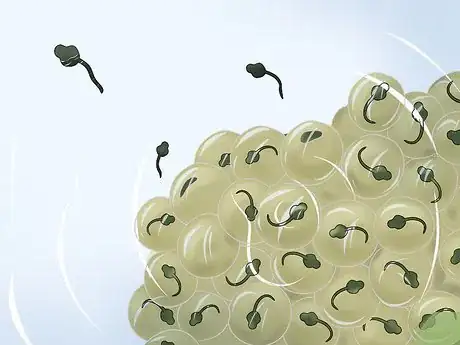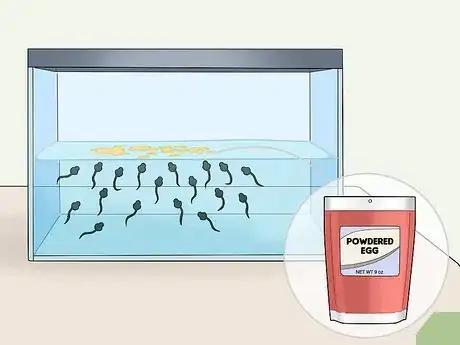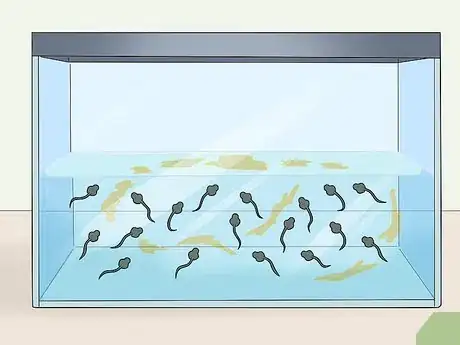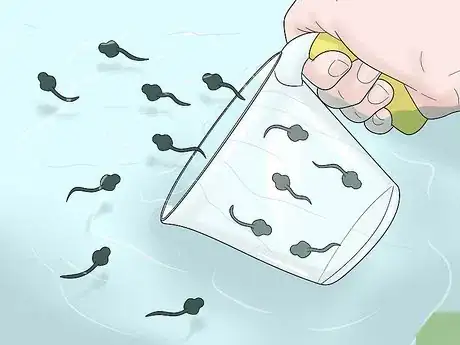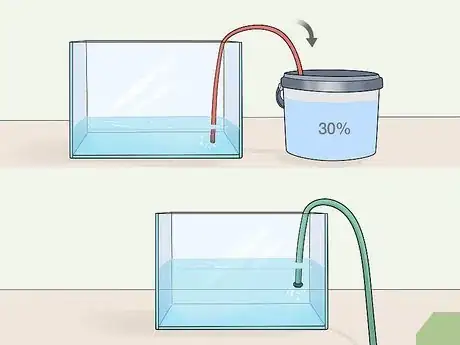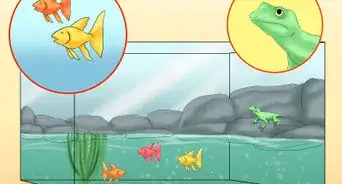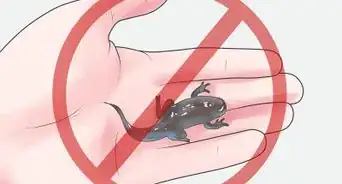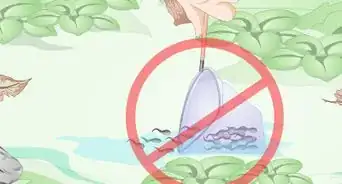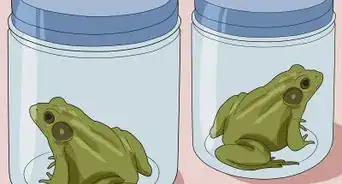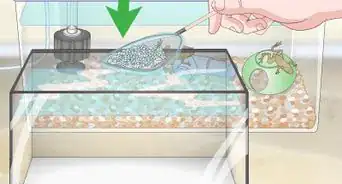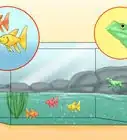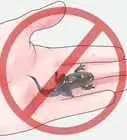This article was co-authored by Pippa Elliott, MRCVS. Dr. Elliott, BVMS, MRCVS is a veterinarian with over 30 years of experience in veterinary surgery and companion animal practice. She graduated from the University of Glasgow in 1987 with a degree in veterinary medicine and surgery. She has worked at the same animal clinic in her hometown for over 20 years.
wikiHow marks an article as reader-approved once it receives enough positive feedback. In this case, 97% of readers who voted found the article helpful, earning it our reader-approved status.
This article has been viewed 55,917 times.
Whether you’re intentionally planning on caring for African Clawed frog tadpoles or woke up one day to discover eggs in your frog’s tank, it’s important to understand how to properly care for tadpoles so that you can successfully raise them into adult frogs. Thankfully, it’s easy to care for the eggs and once you know how to feed the tadpoles and to prepare them for adulthood, you’ll be on your way to raising full grown African Clawed frogs!
Steps
Caring for the Eggs
-
1Separate tadpole eggs from the adults. A female frog can lay anywhere from 500 to 1,000 eggs and the rate of survival depends on the conditions of the tank. The most important factor is to keep the adults separate from the eggs. Otherwise, the tadpole eggs are in danger of being eaten by the adults.[1]
- After you notice the first egg, watch out for more to follow in the next 2-4 days. There’s a good chance the eggs will hatch at night, so check the tank every morning.
- Dedicate one tank to the eggs. The tank should be fairly wide but not overly tall.
- A good tank size is anywhere from 6-10 gallons with a water level of 7-12 inches deep.[2]
- Keep the water temperature a bit higher for tadpoles at around 75 degrees fahrenheit. Once the tadpoles are older, they can be kept in water that is slightly cooler at 70 degrees fahrenheit. You can purchase an aquarium heater from a local pet store, to heat the water. Just be sure to have a thermometer in the water so that you can monitor the temperature.
- This is also the point where you need to decide how many frogs you'd ultimately like to raise, as most of the tadpoles will reach maturity so long as the environment is suitable.
-
2Watch for the eggs to hatch. Eggs typically hatch within 2-4 days.[3] Once hatched, the tadpoles will be white in color, transparent and extremely tiny.
- Despite their initial small size the tadpoles will grow quickly. This is why it’s so important to keep the eggs in a large tank.[4]
Advertisement -
3Look for them to swim freely. Being able to swim freely is a big milestone in the life of a tadpole. Initially, they will simply attach themselves to the side of the tank, but within a few days you’ll notice they will be swimming head down.
- This is an important milestone in the life of a tadpole, but it’s also your cue to start feeding them. Up until this point they will be living off of the yolk sac they are born in.
Feeding the Tadpoles
-
1Feed the tadpoles once they start swimming freely. Now that the tadpoles are swimming freely, it’s time to feed them tadpole food. There are a few different food options including powdered egg and extremely fine goldfish food.
- You can find powdered egg at major retail stores such as Walmart. Goldfish food can also be found at major stores or pet supply stores.
- If you choose to use goldfish food, the flakes will need to be ground into a powder. You can use a mortar and pestle to grind the flakes into a fine powder.
- Tadpoles should not be overfed. A good rule of thumb is to create a small “O” of food for each of the tadpoles at the top of the tank. The "O" should be small and roughly the same size as 14 point font. That should be sufficient for the day.[5]
-
2Make sure they aren’t taking too long to eat. If you notice the tadpoles are taking longer than an hour and a half to eat, this is an indication that they are being overfed. It is actually dangerous to overfeed the tadpoles, as the excess food accumulates in the tank and prevents oxygen from getting to the tadpoles.[6]
- Because of their transparent appearance, you can actually see the food in their stomachs. Their bellies should not be bloated.
- If they are being overfed, make the “O” of food slightly smaller. Continue to monitor their eating habits. As they grow, you may need to increase the amount of food you’re feeding them.
-
3Ensure the food is circulating properly. It’s important to make sure the food is small enough and circulating properly. Tadpoles don’t have a mouth at this stage, so food is absorbed through a filter. If the food isn’t circulating they aren’t able to receive the proper nourishment.[7]
- Make sure to space out the “O’s” of food. Do not place them all in one spot. Having an adequate amount of water, about one liter per tadpole, will help to ensure there is enough space to properly spread out the food.
Preparing the Tadpoles for Adulthood
-
1Use a scoop instead of a net. To ensure the survival of your tadpoles, never use a net to touch or retrieve them. If you must move them, use a cup to gently scoop them out of their current space and into a new one.[8]
- Similarly, you should never use your hands as a method for transporting tadpoles. This is just as dangerous as using a net.
-
2Change out 20-30% of the water every day. It is crucial to the tadpole’s survival to keep their tank clean. Changing out a part of the tadpole’s water every day will help to ensure the cleanliness of both the tank and water.[9]
- You do not need to empty the entire tank on a daily basis. Instead, you should carefully scoop out about 20-30% of the old water and replace it with fresh, clean water.
- Use either bottled water or de-chlorinated water. However, as long as the water isn't overly acidic your tadpoles should thrive.[10]
-
3Clean the tank every week to two weeks. Even though the aquarium only needs to be cleaned on a weekly or every other week basis you should still try to inspect it every day to ensure its' cleanliness.
- To clean the bottom of the tank, try using a turkey baster. This will help you to extract some of the dirt and debris at the bottom, without disturbing the tadpoles.
- When you do fully clean the tank, transfer the tadpoles to another temporary tank. Make sure the water conditions are similar to that of their aquarium.
- Once the tadpoles have been moved, thoroughly clean the tank and sterilize everything including any decor. Use a cleaning product that is reptile friendly. Products can be found at any major retail store or specialty pet store.[11]
- Tadpoles are sensitive to their environment, so in order to ensure their survival, be sure to keep up with the regular cleaning. As long as the environment is kept clean, you should expect the majority of your tadpoles to reach adulthood.
-
4Switch the tadpoles to adult food. You will need to closely monitor your tadpoles for physical changes, which indicate they are ready for adult food. Some of these physical changes include the appearance of front legs, as well as the disappearance of their tail.[12]
- The appearance of front legs is your first sign that your tadpole will be transforming. Make note of this change on a calendar.
- Wait for the tail to shrink down to a stump. At this point, you should begin feeding the tadpole adult food.
- It will take approximately 10 days, from the appearance of front legs, for the tail to shrink to a stump. By marking the date on a calendar, you’ll have a good idea as to when you’ll need to purchase adult food.
- Lean, raw beef or an earthworm is an acceptable first food for the adult frog. The food should be bite-sized so that they are able to easily consume it. Plan on feeding them only 3-4 times a week.
Warnings
- Tadpoles swim head down so even though they may appear to be dead, they are not.⧼thumbs_response⧽
- Never use a net to retrieve tadpoles, as they are extremely delicate.⧼thumbs_response⧽
- The tadpoles are filter-feeding so feed them powdered fish food only.⧼thumbs_response⧽
Things You'll Need
- A short, wide tank
- 1 liter of water for every tadpole
- A scoop
- Turkey baster
- Aquarium heater
- Thermometer
References
- ↑ http://www.theamphibian.co.uk/african_clawed_frog_care_sheet.htm
- ↑ http://www.theamphibian.co.uk/african_clawed_frog_care_sheet.htm
- ↑ http://blogs.thatpetplace.com/thatreptileblog/2011/08/09/breeding-the-african-clawed-frog/#.VwcYAxMrLrI
- ↑ http://www.frogsafe.org.au/ponds/raising_tadpoles.shtml
- ↑ http://www.petstation.com/clfrog.html
- ↑ http://wetwebmedia.com/FWSubWebIndex/FrogsArtNeale.htm
- ↑ http://www.frogsafe.org.au/ponds/raising_tadpoles.shtml
- ↑ http://www.theamphibian.co.uk/african_clawed_frog_care_sheet.htm
- ↑ http://wetwebmedia.com/FWSubWebIndex/FrogsArtNeale.htm
About This Article
To care for African Clawed frog tadpoles, start feeding them powdered egg and extremely fine goldfish food once they start swimming freely. When you feed them, keep an eye on the tank to make sure the food is small enough for them to consume and circulating properly. If you notice the tadpoles are taking longer than an hour and a half to eat, you may be overfeeding them, so cut back food portions. Also, be sure to change out 20-30% of the water every day and thoroughly clean the tank every two weeks to keep the tadpoles healthy. For tips on when to switch the tadpoles to adult food, read on!
